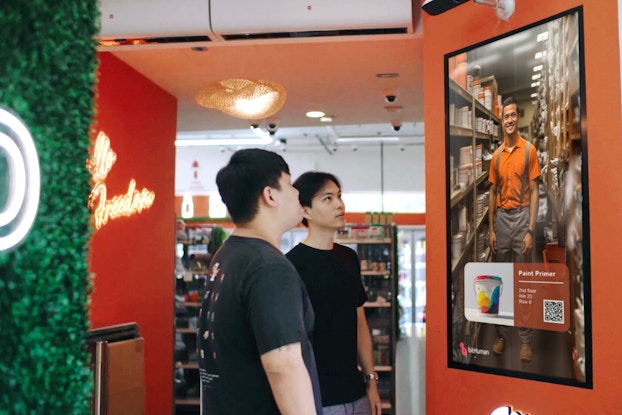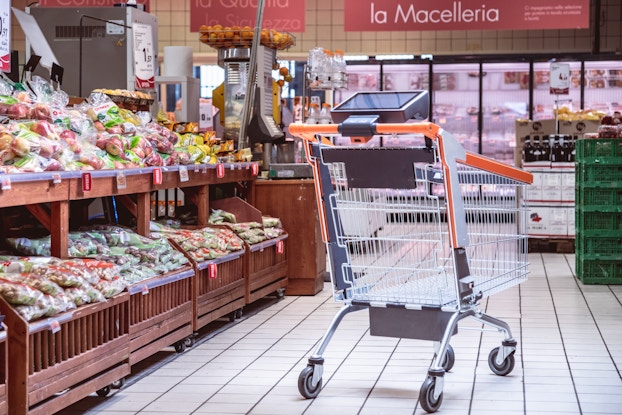
Why it matters:
- Retailers are leading the way with tech-powered innovations, but the changes will impact all customer-facing businesses.
- Consumers are saying they prefer to interact with technology, rather than live staff, for tasks ranging from checkout to getting product information.
- Retail executives expect spending on new technology to increase, on average, by 10% this year, and 94% of those surveyed said technology is a significant growth driver.
This year is expected to be a transformative one for retailers, as the nation’s merchants adopt new technologies at a faster pace than ever before.
A study by IT consulting firm SoftServe predicts a surge in retail technology spending, with retail executives expecting to spend an average of 10% more on technology investments this year.
Retailers are bullish on technology right now because in 2023 they saw dramatic gains in sales growth and efficiency, as well as cost savings, driven by rapid advancements in artificial intelligence applications.
Sixty-nine percent of retailers surveyed by tech company Nvidia credited AI with boosting their revenues in 2023. Seventy-two percent said AI helped them cut operating expenses.
Consumers also are eager to use AI to make purchases more convenient, and some are finding tech assistants to be more efficient than human retail workers.
More than one-fourth of consumers said they prefer tech assistants instead of live staff for checking product inventory, ordering out-of-stock items, researching a product, picking up items ordered online, or using checkout, according to the Future of Commerce report from payments platform Square.
Retail executives from around the world came to New York City in January for their industry’s annual convention and trade show, hosted by the National Retail Federation, in the mood to spend on innovation.
Retailers, said Walmart U.S. President and CEO John Furner at the convention, “know the value of looking ahead at the future.”
“Everything around you is changing and to succeed you must stay out in front of change,” he said, quoting a favorite saying of Walmart founder Sam Walton.
Retailers and vendors at the show unveiled a number of new technologies that highlight these top innovations poised to transform the shopping experience.
AI “finally enables us to have these more individualized, personalized experiences with each consumer, at scale.Jason Goldberg, Chief Commerce Strategy Officer, Publicis
Skip-the-checkout will replace self-checkout
Retailers are seeking to make in-store shopping as easy as clicking a “buy now” button online with tech ranging from mobile apps that scan purchases to smart shopping carts that register everything a customer takes off a shelf.
Walmart announced in January that it is using breakthrough AI and computer-vision tech to pilot a “Scan & Go” checkout at 10 of its Sam’s Club stores. The technology, which Walmart plans to roll out to all of its Sam’s Club stores by the end of this year, lets customers who have scanned and purchased items on their mobile phones leave the stores without having to line up to have their purchases and receipts checked by a staff person at the exit.
Several companies at the retail show were exhibiting smart shopping carts that can scan and keep a running price total on everything a shopper throws into a cart.
One of the companies, Tracxpoint, has successfully completed a test of its smart cart at an Italian grocery store chain that plans to expand the carts to more than 100 locations.
Another company, Kwikkart, is focusing on creating a smart cart that will help grocery delivery drivers for platforms like Shipt, Instacart, or DoorDash to shop and exit stores quickly.
AI-fueled virtual shopping assistants will take many forms — from digital ‘humanoids’ to celebrity holograms
This year will see retailers rushing to roll out a broad array of virtual helpers designed to recommend products, answer questions, and serve as AI-driven personal shoppers for consumers.
These virtual assistants can be chatbots on e-commerce sites or mobile phones, digital “humanoids” that appear on a television screen and answer questions, or even hologram projections intended to entertain shoppers with images of celebrities serving as in-store helpers.
The country’s two biggest retailers, Walmart and Amazon, both announced AI-powered shopping recommendation tools in January.
Amazon is calling its virtual shopping assistant Rufus, and is offering it to a small test group of customers using the Amazon mobile app. Rufus is designed to be able to answer questions such as, “What do I need to start an indoor garden?” and offer lists of multiple related products.
Walmart, at the consumer electronics show CES, announced a similar generative-AI driven tool that lets shoppers ask questions like, “Help me plan a Super Bowl party,” or “What do I need for a unicorn birthday party for a five-year-old?”
“You’re actually enabling the customer to find things that they never knew were available when they had to search one-by-one for items,” Anshu Bhardwaj, Senior Vice President and Chief Operating Officer, Walmart Global Technology and Walmart Commerce Technologies, said in a presentation at the retail trade show.
Companies are also developing virtual shopping assistants for in-store shoppers. At the retail show, California-based tech company bitHuman introduced retailers to its virtual assistants – human-like avatars projected on television screens who can understand spoken questions and provide information about where products are located in a store, or offer other store information.
Steven Gu, bitHuman CEO and Co-founder, said at the show that the virtual assistants are designed to serve as greeters at stores, and save shoppers the trouble of hunting down store employees to ask where they can find something. The virtual assistants also will be able to help place orders for out-of-stock items.
Toronto-based tech company ARHT was displaying hologram technology that can be used to show shoppers 3-D images of virtual store greeters, or to livestream celebrities or influencers into stores for customer experiences or promotions.

Tech will enable retailers to glean data on in-store shopping patterns akin to online merchants
Dozens of companies at the trade show were offering AI-augmented in-store analytics as a way to give retailers the kind of in-depth data about shopping patterns that they can easily get from their e-commerce sites.
While e-commerce retailers can tell what product pages a shopper looked at or how long they browsed before buying, or at what point they abandoned their cart and left the site, they have struggled to get that kind of information about store shoppers.
Stores have long used in-store cameras for traffic counting and theft prevention, but now AI and computer vision tools are allowing them to use those images to gather store analytics and insights.
AI platforms can glean information about shopper demographics, traffic patterns in stores, or time spent browsing, while keeping images of shoppers anonymized.
That information can also be used to help retailers advertise in-store to shoppers, and to sell ads to brands who want to reach in-store consumers.
Advertima, a Swiss tech company exhibiting at the retail show, links its AI and computer vision tech with smart screens in stores that can display ads. The technology, Advertima executives explained at the show, lets stores monetize their shopper audience and offer that audience to brands in real time. Brands then can bid for a chance to reach that audience, similar to the way online and social media advertising works.
Ads and product recommendations will hyper-target specific consumers
AI increasingly is enabling retailers and brands to customize ads and make product recommendations that are personalized to specific customers. Generative AI platforms, which create ad content, will aid in that personalization effort.
AI “finally enables us to have these more individualized, personalized experiences with each consumer, at scale,” Jason Goldberg, Chief Commerce Strategy Officer at Publicis, said in a January webinar hosted by location analytics firm Placer.ai.
“When we look back at 2024, we’re going to say, ‘Hey, that’s the year that Walmart just magically started putting the right stuff in my shopping cart and they earned my loyalty as a result,” or similar experiences with other retailers, Goldberg said.
He believes that by the end of this year, the version of creative and promotional content a person sees will be directly related to the context in which the were led to encounter the ad. And the context, he said, is “going to make that add look different for you than anyone else.”
That means, Goldberg said, “We’re going to have to learn not to have conversations like, ‘Hey did you see that ad at the Super Bowl?’ because we’re all going to have ended up seeing different ads.”
CO— aims to bring you inspiration from leading respected experts. However, before making any business decision, you should consult a professional who can advise you based on your individual situation.
CO—is committed to helping you start, run and grow your small business. Learn more about the benefits of small business membership in the U.S. Chamber of Commerce, here.

Interested in a small business membership?
Find out how the U.S. Chamber of Commerce can help your company grow and thrive in today's rapidly-evolving business environment. Connect with our team to learn how a small business membership can benefit your bottom line and help you achieve your goals.







